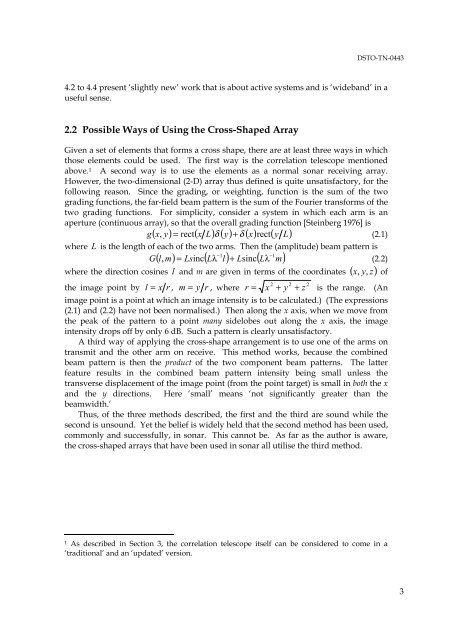Suitability of Correlation Arrays and Superresolution for Minehunting ...
Suitability of Correlation Arrays and Superresolution for Minehunting ...
Suitability of Correlation Arrays and Superresolution for Minehunting ...
Create successful ePaper yourself
Turn your PDF publications into a flip-book with our unique Google optimized e-Paper software.
DSTO-TN-0443<br />
4.2 to 4.4 present ‘slightly new’ work that is about active systems <strong>and</strong> is ‘wideb<strong>and</strong>’ in a<br />
useful sense.<br />
2.2 Possible Ways <strong>of</strong> Using the Cross-Shaped Array<br />
Given a set <strong>of</strong> elements that <strong>for</strong>ms a cross shape, there are at least three ways in which<br />
those elements could be used. The first way is the correlation telescope mentioned<br />
above. 1 A second way is to use the elements as a normal sonar receiving array.<br />
However, the two-dimensional (2-D) array thus defined is quite unsatisfactory, <strong>for</strong> the<br />
following reason. Since the grading, or weighting, function is the sum <strong>of</strong> the two<br />
grading functions, the far-field beam pattern is the sum <strong>of</strong> the Fourier trans<strong>for</strong>ms <strong>of</strong> the<br />
two grading functions. For simplicity, consider a system in which each arm is an<br />
aperture (continuous array), so that the overall grading function [Steinberg 1976] is<br />
g( x, y) = rect( x L) δ ( y) + δ ( x) rect( y L)<br />
(2.1)<br />
where L is the length <strong>of</strong> each <strong>of</strong> the two arms. Then the (amplitude) beam pattern is<br />
−1<br />
−1<br />
G( l,<br />
m) = Lsinc( Lλ<br />
l) + Lsinc( Lλ<br />
m)<br />
(2.2)<br />
where the direction cosines l <strong>and</strong> m are given in terms <strong>of</strong> the coordinates ( x , y,<br />
z)<br />
<strong>of</strong><br />
2 2 2<br />
the image point by l = x r , m = y r , where r = x + y + z is the range. (An<br />
image point is a point at which an image intensity is to be calculated.) (The expressions<br />
(2.1) <strong>and</strong> (2.2) have not been normalised.) Then along the x axis, when we move from<br />
the peak <strong>of</strong> the pattern to a point many sidelobes out along the x axis, the image<br />
intensity drops <strong>of</strong>f by only 6 dB. Such a pattern is clearly unsatisfactory.<br />
A third way <strong>of</strong> applying the cross-shape arrangement is to use one <strong>of</strong> the arms on<br />
transmit <strong>and</strong> the other arm on receive. This method works, because the combined<br />
beam pattern is then the product <strong>of</strong> the two component beam patterns. The latter<br />
feature results in the combined beam pattern intensity being small unless the<br />
transverse displacement <strong>of</strong> the image point (from the point target) is small in both the x<br />
<strong>and</strong> the y directions. Here ‘small’ means ‘not significantly greater than the<br />
beamwidth.’<br />
Thus, <strong>of</strong> the three methods described, the first <strong>and</strong> the third are sound while the<br />
second is unsound. Yet the belief is widely held that the second method has been used,<br />
commonly <strong>and</strong> successfully, in sonar. This cannot be. As far as the author is aware,<br />
the cross-shaped arrays that have been used in sonar all utilise the third method.<br />
1 As described in Section 3, the correlation telescope itself can be considered to come in a<br />
‘traditional’ <strong>and</strong> an ‘updated’ version.<br />
3

















